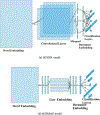Deep learning uncertainty quantification for clinical text classification
- PMID: 38101690
- PMCID: PMC11467893
- DOI: 10.1016/j.jbi.2023.104576
Deep learning uncertainty quantification for clinical text classification
Abstract
Introduction: Machine learning algorithms are expected to work side-by-side with humans in decision-making pipelines. Thus, the ability of classifiers to make reliable decisions is of paramount importance. Deep neural networks (DNNs) represent the state-of-the-art models to address real-world classification. Although the strength of activation in DNNs is often correlated with the network's confidence, in-depth analyses are needed to establish whether they are well calibrated.
Method: In this paper, we demonstrate the use of DNN-based classification tools to benefit cancer registries by automating information extraction of disease at diagnosis and at surgery from electronic text pathology reports from the US National Cancer Institute (NCI) Surveillance, Epidemiology, and End Results (SEER) population-based cancer registries. In particular, we introduce multiple methods for selective classification to achieve a target level of accuracy on multiple classification tasks while minimizing the rejection amount-that is, the number of electronic pathology reports for which the model's predictions are unreliable. We evaluate the proposed methods by comparing our approach with the current in-house deep learning-based abstaining classifier.
Results: Overall, all the proposed selective classification methods effectively allow for achieving the targeted level of accuracy or higher in a trade-off analysis aimed to minimize the rejection rate. On in-distribution validation and holdout test data, with all the proposed methods, we achieve on all tasks the required target level of accuracy with a lower rejection rate than the deep abstaining classifier (DAC). Interpreting the results for the out-of-distribution test data is more complex; nevertheless, in this case as well, the rejection rate from the best among the proposed methods achieving 97% accuracy or higher is lower than the rejection rate based on the DAC.
Conclusions: We show that although both approaches can flag those samples that should be manually reviewed and labeled by human annotators, the newly proposed methods retain a larger fraction and do so without retraining-thus offering a reduced computational cost compared with the in-house deep learning-based abstaining classifier.
Keywords: Abstaining classifier; Accuracy; CNN; DNN; Deep learning; HiSAN; NCI SEER; Pathology reports; Selective classification; Text classification; Uncertainty quantification.
Published by Elsevier Inc.
Conflict of interest statement
Declaration of competing interest The authors declare that they have no known competing financial interests or personal relationships that could have appeared to influence the work reported in this paper.
Figures






References
-
- Qiu JX, Yoon H-J, Fearn PA, Tourassi GD, Deep learning for automated extraction of primary sites from cancer pathology reports, IEEE J. Biomed. Health Inform 22 (1) (2017) 244–251. - PubMed
-
- Hughes M, Li I, Kotoulas S, Suzumura T, Medical text classification using convolutional neural networks, in: Informatics for Health: Connected Citizen-Led Wellness and Population Health, IOS Press, 2017, pp. 246–250. - PubMed
-
- Gao S, Qiu JX, Alawad M, Hinkle JD, Schaefferkoetter N, Yoon H-J, Christian B, Fearn PA, Penberthy L, Wu X-C, et al., Classifying cancer pathology reports with hierarchical self-attention networks, Artif. Intell. Med 101 (2019) 101726. - PubMed
-
- Alawad M, Gao S, Qiu JX, Yoon HJ, Blair Christian J, Penberthy L, Mumphrey B, Wu X-C, Coyle L, Tourassi G, Automatic extraction of cancer registry reportable information from free-text pathology reports using multitask convolutional neural networks, J. Am. Med. Inform. Assoc 27 (1) (2020) 89–98. - PMC - PubMed
Publication types
MeSH terms
Grants and funding
- HHSN261201100007I/CA/NCI NIH HHS/United States
- HHSN261201800013C/CA/NCI NIH HHS/United States
- T32 CA160003/CA/NCI NIH HHS/United States
- HHSN261201800014I/CA/NCI NIH HHS/United States
- U58 DP003907/DP/NCCDPHP CDC HHS/United States
- HHSN261201800013I/CA/NCI NIH HHS/United States
- HHSN261201800007C/CA/NCI NIH HHS/United States
- HHSN261201800014C/CA/NCI NIH HHS/United States
- HHSN261201800016C/CA/NCI NIH HHS/United States
- HHSN261201300007I/CA/NCI NIH HHS/United States
- HHSN261201800016I/CA/NCI NIH HHS/United States
- P30 CA177558/CA/NCI NIH HHS/United States
- HHSN261201300021C/CA/NCI NIH HHS/United States
LinkOut - more resources
Full Text Sources

